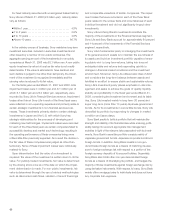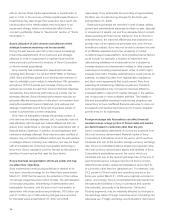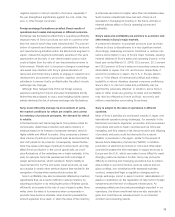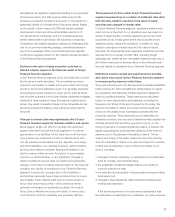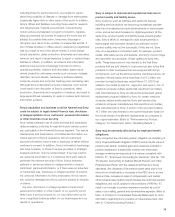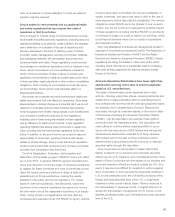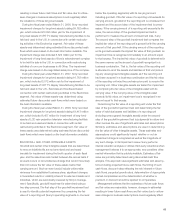Sony 2008 Annual Report Download - page 76
Download and view the complete annual report
Please find page 76 of the 2008 Sony annual report below. You can navigate through the pages in the report by either clicking on the pages listed below, or by using the keyword search tool below to find specific information within the annual report.74
able to recover these capital expenditures or investments, in
part or in full, or the recovery of these capital expenditures or
investments may take longer than expected. As a result, the
carrying value of the related assets may be subject to an
impairment charge, which could adversely affect Sony’s
mid-term profitability. (Refer to “Electronics” section of “Trend
Information.”)
Sony’s utilization of joint ventures and alliances within
strategic business areas may not be successful.
During the last several years Sony has moved increasingly
toward the establishment of joint ventures and strategic
alliances in order to supplement or replace functions that
were previously performed by divisions of Sony Corporation
or wholly-owned subsidiaries.
Sony currently has investments in several joint ventures,
including Sony Ericsson, S-LCD and SONY BMG. In February
2008, Sony and Sharp signed a non-binding memorandum of
intent to establish a joint venture to manufacture 10th generation
amorphous TFT LCD panels and modules. If Sony and its
partners are not able to reach their common financial objectives
successfully, Sony’s financial performance as a whole may be
adversely affected. Sony’s financial performance may also be
adversely affected temporarily or in the short- and medium-term
during the investment period of alliances, joint ventures and
strategic investments even if Sony and its partners remain on
course to achieve their common objectives.
Sony may not adequately manage the growing number of
joint ventures and strategic alliances, and, in particular, may not
deal effectively with the legal and cultural differences that can
arise in such relationships or changes in the relationships with or
financial status of partners. In addition, by participating in joint
ventures or strategic alliances, Sony may encounter conflicts of
interest, may not maintain sufficient control over the joint venture
or strategic alliance, including over cash flow, and may be faced
with an increased risk of the loss of proprietary technology or
know-how. Sony’s reputation could be harmed by the actions or
activities of a joint venture that uses the Sony brand.
Sony’s business reorganization efforts are costly and may
not attain their objectives.
Sony implemented restructuring initiatives in relation to its
mid-term corporate strategy for the three fiscal years ended
March 31, 2008 that focused on the reduction of the number
of business categories and product models, the rationalization
of manufacturing sites, streamlining of administrative and
headquarter functions, and the sale of non-core assets. In
association with these restructuring initiatives, 38.8 billion yen
and 47.3 billion yen of restructuring charges were recorded
for the fiscal years ended March 31, 2007 and 2008,
respectively. Sony anticipates the recording of approximately
20 billion yen of restructuring charges for the fiscal year
ending March 31, 2009.
Restructuring charges are recorded in cost of sales, selling,
general and administrative expenses and loss on sale, disposal
or impairment of assets, net and thus decrease Sony’s consoli-
dated operating and net income. Moreover, due to internal or
external factors, the improved efficiencies and projected cost
savings may not be realized as scheduled and, even if those
benefits are realized, Sony may not be able to achieve the level
of profitability expected due to the worsening of market
conditions beyond expectations. Such possible internal factors
could include, for example, a decision to implement new
restructuring initiatives not already planned or a decision to
increase research and development outlays or other expendi-
tures beyond currently projected levels, either of which might
increase total costs. Possible external factors could include, for
example, increased burdens from regional labor regulations
and labor union agreements that could prevent Sony from
executing its restructuring initiatives as planned. Therefore,
such reorganizations may not result in improved efficiency,
increased ability to respond to market changes or the realloca-
tion of resources to more profitable activities. The inability to
fully and successfully implement restructuring programs may
cause Sony to have insufficient financial resources to carry out
its research and development plans and to invest in targeted
growth areas for its businesses.
Foreign exchange rate fluctuations can affect financial
results because a large portion of Sony’s sales and assets
are denominated in currencies other than the yen.
Sony’s consolidated statements of income are prepared from
the local currency-denominated financial results of Sony
Corporation’s subsidiaries around the world, which are then
translated into yen at the monthly average currency exchange
rate. Sony’s consolidated balance sheets are prepared using
the local currency-denominated assets and liabilities of Sony
Corporation’s subsidiaries around the world, which are
translated into yen at the market exchange rate at the end of
each financial period. A large proportion of Sony’s consoli-
dated financial results, assets and liabilities is accounted for
in currencies other than the Japanese yen. For example, only
23.2 percent of Sony’s sales and operating revenue in the
fiscal year ended March 31, 2008 were originally recorded in
Japan. Accordingly, Sony’s consolidated financial results and
the assets and liabilities in Sony’s businesses that operate
internationally, principally in its Electronics, Game and
Pictures segments, may be materially affected by changes in
the exchange rates of foreign currencies when translating into
Japanese yen. Foreign exchange rate fluctuations may have a




